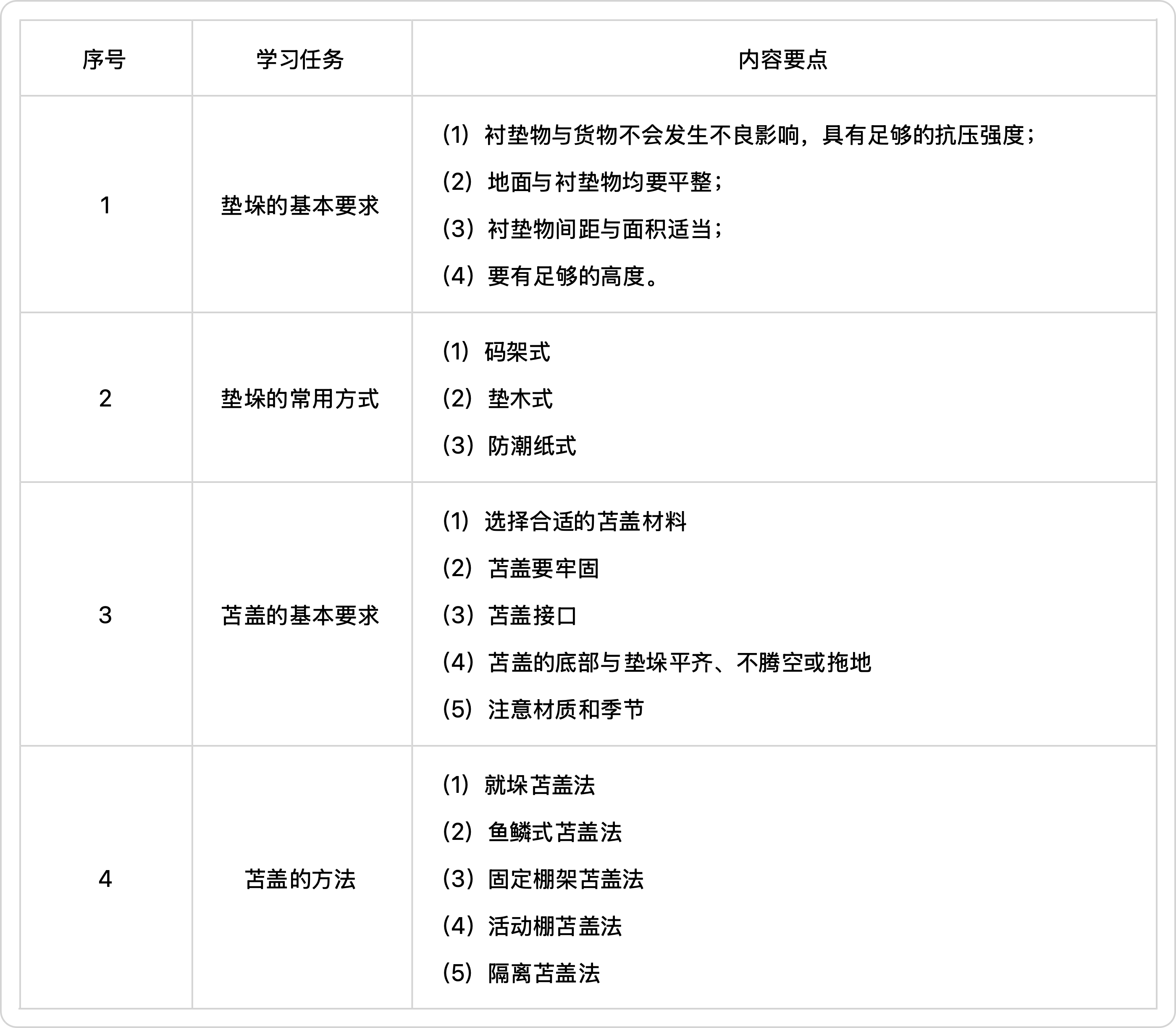任务2 货物的垫垛与苫盖
Task Two Cushioning and Covering of Goods
任务导入 Lead-in
库存组张组长:小孙,今天上午有一批货物需要入库,等收货组完成收货作业后,请你协助完成货物的垫垛和苫盖。
库存组员孙林:好的组长,垫垛和苫盖的材料已经准备好了,到时我会跟收货组进行工作交接。
库存组张组长:注意衬垫物的摆放一定要平整,另外近期降雨频繁,注意垫垛高度要足够。
库存组员孙林:好的组长,我一定会严格按照要求进行苫垫,请放心。
库存组张组长:好,辛苦了。
Leader Zhang of Inventory Team: Xiao Sun, there is a batch of goods that need to be put into storage this morning, and after the receiving team completes the receiving operation, please assist in completing the cushioning and covering of the goods.
Member Sun Lin of Inventory Team: Okay, Mr.Zhang. The materials for the cushioning and covering have been prepared, and I will hand over them with the receiving team at that time.
Leader Zhang of Inventory Team: Be noted that the placement of the liner must be smooth. Make sure the height of the cushion is sufficient due to recent frequent rainfall.
Member Sun Lin of Inventory Team: Okay, Mr.Zhang. I will definitely protect the goods from being influenced by weather in strict accordance with the requirements, please rest assured.
Leader Zhang of Inventory Team: Okay, thank you for your hard work.
垫垛的基本要求与方式 The Basic Requirements and Methods For Cushioning
垫垛的基本要求
(1)所使用的衬垫物与拟存货物不会发生不良影响,具有足够的抗压强度;
(2)地面要平整坚实、衬垫物要摆平放正,并保持同一方向;
(3)衬垫物间距适当,直接接触货物的衬垫面积与货垛底面积相同,垫物不伸出货垛外;
(4)要有足够的高度,露天堆场要达到0.3-0.5m,库房内0.2m即可。
The basic requirements for cushioning
(1)The cushion used will not be adversely affected by the goods and it has sufficient compressive strength;
(2)The ground should be flat and solid, and the cushion should be placed flat and upright, and keep the same direction;
(3)The spacing of the liner is appropriate, the area of the liner in direct contact with the goods is the same as the bottom area of the stack, and the cushion does not extend out of the stack;
(4)The height should be enough. The open yard should be 0.3-0.5m, and the warehouse can be 0.2m.
常用的垫垛方式
(1)码架式。即采用若干个码架,拼成所需货垛底面积的大小和形状,以备堆垛。码架是用垫木为脚,上面钉着木条或木板的构架,专门用于垫垛。码架规格不一常见的有:长2m、宽1m、高0.2m或0.1m。不同储存条件,所需码架的高度不同:楼上库房使用的码架,高度一般为0.1m;平库房使用的码架,高度一般为0.2m;货棚、货场使用的码架高度一般在0.3-0.5m。
(2)垫木式。即是采用规格相同的若干根枕木或垫石,按货位的大小、形状排列,作为垛垫,枕木和垫石一般都是长方体的,其宽和高相等,约为0.2m,枕木较长约2m左右,而垫石较短约0.3m左右。这种垫垛方法最大的优点是,拼拆方便,不用时节省储存空间。适用于底层库房及货棚、货场垫垛。
(3)防潮纸式。即在垛底铺上一张防潮纸作为垛垫。常用芦席、油毡、塑料薄膜等防潮纸,适用于地面干燥的库房,同时储存的物品对通风要求又不高时,可在垛底垫一层防潮纸防潮。
此外,若采用货架存货,或采用自动化立体仓库的高层货架存货,则货垛下面可以不用垫垛。
Commonly used cushioning methods
(1)Stacking type. That is, a plurality of stacking racks are used to assemble the size and shape of the required bottom area of the stack to prepare for stacking. A stacking rack is a frame with skids as feet and wooden strips or planks nailed to it, which is specially used for cushioning. The specifications of the yard racks are 2m long, 1m wide, 0.2m or 0.1m high. Different storage conditions, the height of the required rack is different: the height of the yard rack used in the upstairs warehouse is generally 0.1m, the height of the yard frame used in the flat warehouse is generally 0.2m, and the height of the yard is generally 0.3-0.5m.
(2)Skid-type. That is, a number of sleepers or stepping stones of the same specification are used, arranged according to the size and shape of the cargo space, as a stacking pad, the sleepers and stepping stones are generally rectangular, their width and height are equal, about 0.2m, the sleepers are about 2m longer, and the stepping stones are shorter about 0.3m. The biggest advantage of this cushioning method is that it is easy to assemble and disassemble, and saves storage space when not in use. It is suitable for the bottom floor warehouse, cargo shed and freight yard stacking.
(3)Moisture-proof paper type. That is, a piece of moisture-proof paper is laid on the bottom of the stack as a stacking pad. Commonly used reed mats, linoleum, plastic film and other moisture-proof paper, suitable for the ground dry warehouse, while the stored items do not require high ventilation, can be at the bottom of the stack with a layer of moisture-proof paper moisture-proof.
In addition, if shelf inventory is used, or high-rise shelf inventory is used in automated three-dimensional warehouse, there is no need for cushion under the stack.
苫盖的基本要求与方法 The Basic Requirements and Methods for Covering
苫盖的基本要求
(1)选择合适的苫盖材料。选用符合防火、无害的安全苫盖材料:苫盖材料不会与货物发生不利影响;成本低廉,不易损坏,能重复使用;没有破损和霉烂。
(2)苫盖要牢固。每张苫盖材料都需要牢固固定,必要时在苦盖物外用绳索、绳网绑扎或者采用重物镇压,确保刮风揭不开。
(3)苫盖接口。苫盖的接口要有一定深度的互相叠盖,不能迎风叠口或留空隙;苫盖必须按挺、平整,不得有折叠和凹陷,防止积水。
(4)苫盖的底部与垫垛平齐、不腾空或拖地,并牢固地绑扎在垫垛外侧或地面的绳桩上,衬垫材料不露出垛外,以防雨水顺延渗入垛内。
(5)要注意材质和季节。使用旧的苫盖物或雨水丰沛季节,垛顶或者风口需要加层苫盖,确保雨淋不透。
The basic requirements of covering
(1)Choose the right covering materials. Choose fireproof and harmless safety materials which will not adversely affect the goods; Materials which are inexpensive, not easy to be damaged, and can be reused; Materials without breakage and mildew.
(2)The materials should be firm. Each material needs to be firmly fastened, and if necessary, it should be tied with ropes, rope nets or heavy objects to ensure that it cannot be removed by wind.
(3)Covering interface. The interfaces of the covering material should be stacked on top of each other at a certain depth, and the mouth should not be stacked in the wind or leave a gap; The lid must be pressed straight and flat, without folding and denting, to prevent water accumulation.
(4)The bottom of the covering material is flush with the stack, not vacated or mopped, and firmly tied to the outside of the stack or on the rope pile on the ground, and the cushioning material is not exposed outside the stack, so as to prevent rainwater from seeping into the stack.
(5)Pay attention to the material and the season. When using old tarpaulin or in rainy seasons, the roof or tuyere needs to be covered with a layer to ensure that the rain is impervious.
苫盖的方法
(1)就垛苫盖法。直接将大面积苫盖材料覆盖在货垛上遮盖。适用于起脊垛或大件包装货物。一般采用大面积的帆布、油布、塑料膜等。就垛苫盖法操作便利,但基本不具有通风条件,适用于对通风要求不高的货物(图2.2.1)。
The method of covering
(1)Stackin method. Cover a large area of tarpaulin directly on the pallet. Suitable for ridged stacking or bulky packaged goods. Generally, large-area canvas, oilcloth, plastic film, etc. are used. It is convenient to use stacking method, but basically the ventilation are poor, and it is suitable for goods with low ventilation requirements. (Figure 2.2.1)
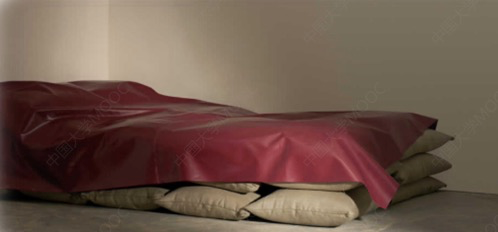
(2)鱼鳞式苫盖法。将苫盖材料从货垛的底部开始,自下而上呈鱼鳞式逐层交叠围盖。该法一般采用面积较小的席、瓦等材料苫盖。鱼鳞式苫盖法具有较好的通风条件,但每件苫盖材料都需要固定,操作比较繁琐复杂(图2.2.2)。
(2)Fish scale method. The material starts from the bottom of the pallet and is layered layer by layer from bottom to top in a fish-scale pattern. This method generally uses small area mats, tiles and other materials to cover. The ventilation is better, but each material needs to be fixed, and the operation is more cumbersome and complicated. (Figure 2.2.2)
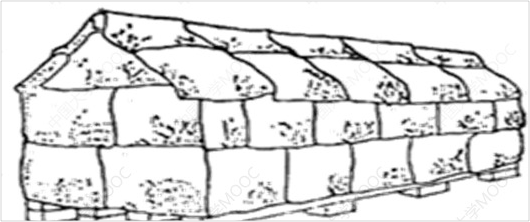
(3)固定棚架苫盖法。固定棚架苫盖法是指用预制的苫盖骨架与苫叶合装而成的简易棚架,但不需基础工程,可随时拆卸和人力移动(图2.2.3)。
(3)Fixed scaffolding method. It refers to a simple scaffolding made of prefabricated tarmaca skeleton and tamama leaves, but does not require basic engineering, and can be disassembled and moved by hand at any time. (Figure 2.2.3)
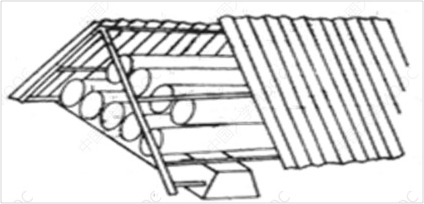
(4)活动棚苫盖法。将苫盖物料制作成一定形状的棚架,在货物堆垛完毕,移动棚架到货垛遮盖,或者采用即时安装活动棚架的方式苫盖。活动棚苫盖法较为快捷,具用良好的通风条件,但活动棚本身需要占用仓库位置,也需要较高的购置成本(图2.2.4)。
(4)Movable shed method. The material is made into a scaffolding of a certain shape, and after the goods are stacked, the scaffold is moved to the pallet to cover, or the movable scaffold is installed immediately. The movable shed method is relatively fast and has good ventilation conditions, but the movable shed itself needs to occupy the warehouse and also requires a high purchase cost. (Figure 2.2.4)
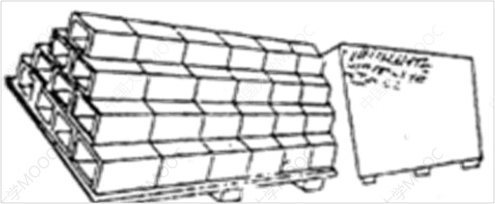
(5)隔离苫盖法。隔离苫盖法是指采用隔离物使苫盖物与货垛间留有一定空隙。隔离物有竹竿、钢管、钢筋、木条、隔离板等。其优点在于垛内通风散潮,便于排水防止雨水渗透(图2.2.5)。
(5)Isolation method. It refers to the use of isolation to leave a certain gap between the tarpaulin and the stack. The isolators include bamboo poles, steel pipes, steel bars, wooden strips, isolation boards, etc. The advantage is that the inside of the stack is ventilated and moisture is dispersed, which is convenient for drainage and prevents rainwater from penetrating. (Figure 2.2.5)
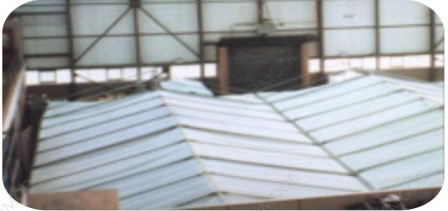
专业核心词汇 Vocabulary
垫垛 cushion
苫盖 covering material
衬垫物 pad
码架 stacking rack
枕木 sleeper
垫石 stepping stone
防潮纸 moisture-proof paper
隔离 isolation
学习拓展 Further Reading
苫盖与垫垛材料的选择
一、苫盖材料的选择
通常使用的苫盖材料有:塑料薄膜(草、芦)席、油毡纸、铁皮铁瓦、纤维瓦、苫布(帆布、油布)等,也可以利用一些物品的旧包装材料改制成苫盖材料。
苦盖材料的选择首先是依据满足苫盖的功能,起到遮挡雨水,挡风遮日晒的目的;其次是方便操作。由于港口货物的苫盖随着货物周转频繁,苫盖、揭盖次数极为频繁,方便操作的苫盖材料会大大降低工作量,因而大面积的帆布是库场苫盖的主要材料。苫盖材料的选择还应具有经济的原则,成本低廉、能重复使用。
二、垫垛材料的选择
通常采用水泥墩、条石、枕木、货板、废旧道轨、垫架、苇席、防潮纸、塑料薄膜、水货架、垫仓板、油布(帆布)、铁架、钢板、水泥预制件(条、块)等。根据不同的储存条件,物品的不同要求,采用不同的垫垛材料。
Selection of Cushioning and Covering Materials
Ⅰ The selection of covering materials
The commonly used materials are: plastic film (grass, reed) mat, linoleum paper, iron tile, fiber tile, tarpaulin (canvas, tarpaulin), etc., and the old packaging materials of some items can also be transformed into cover materials.
The selection of the material of the cover is first based on the function of it, which serves the purpose of shielding rain, wind and sun; The second is ease of operation. Due to the frequent turnover of the port goods, the number of covers and uncoverings is extremely frequent, and the easy operation of the cover material will greatly reduce the workload, so the large area of canvas is the main material of the warehouse tarpaulin. The selection of covering materials should also be economical, inexpensive and reusable.
Ⅱ The selection of cushion materials
Cement piers, stones, sleepers, pallets, waste rails, pads, reed mats, moisture-proof paper, plastic films, water shelves, silo plates, oil cloth (canvas), iron frames, steel plates, cement prefabricated parts (strips, blocks), etc. are usually used. According to different storage conditions and different requirements of items, different cushioning materials are used.
知识巩固 Consolidation
认知题

看图片,选对应的苫盖方法进行连线。
①鱼鳞式苫盖法
②固定棚架苫盖法
③活动棚苫盖法
答案:③ ② ①选择题
在货物入库后,要做好货物质量变化的预防措施,应( )。
A.健全仓库货物保养组织
B.保持仓库的清洁卫生
C.妥善进行堆码和苫垫
D.认真控制库房温湿度
E.做好货物在库质量检查
答案:ABCDE判断题
对有排水性能,不怕雨、雪、风及日光侵蚀的商品,或使用时必须进行再加工的原材料,如生铁等,露天存放也可以不苫盖。 ( )
答案:√技能训练
训练任务 实施货物垫垛与苫盖
【训练目标】
1.熟悉垫垛与苫盖的基本要求。
2.能够根据货物特点选择适当的垫垛与苫盖方式。
【训练内容】
有两批货物已入库完毕,具体信息如表2.2.1所示,根据保管场所的实际情况货物本身的特点装卸搬运条件和仓储作业过程的要求,选择适当的垫垛与苫盖材料及方法,并实施苫垫作业。

【训练步骤】
1.分析上述货物的特点,总结其存储特性。
2.根据货物的存储特性,选择适合的苫垫材料及方法。
3.进行苫垫作业。
【考核评价】
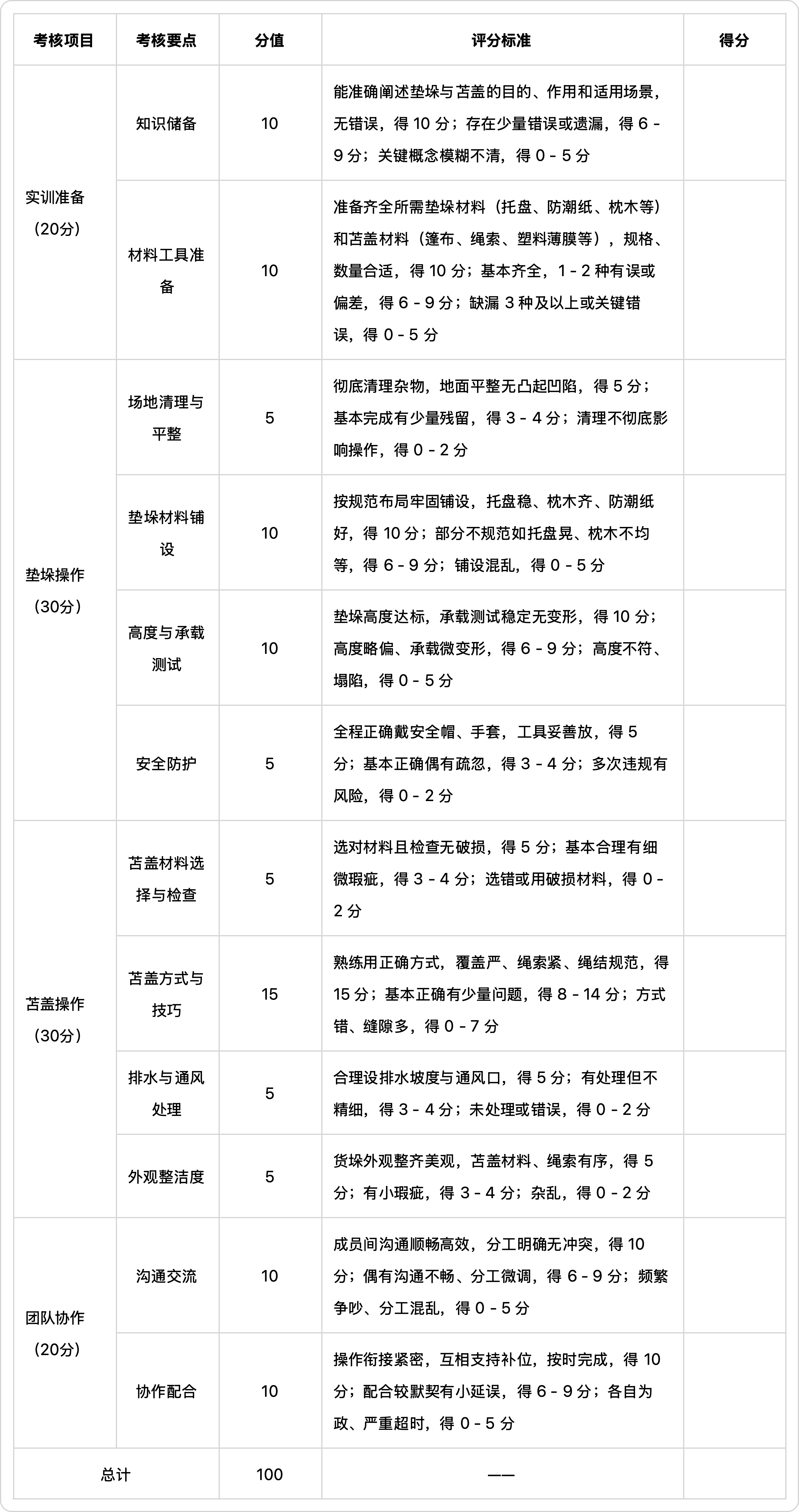
课件
任务小结
本节课学习任务要点梳理如表2.2.2所示:
